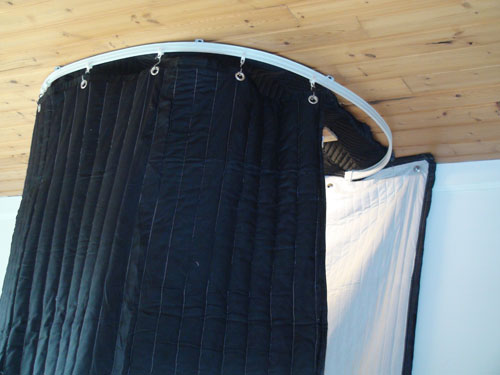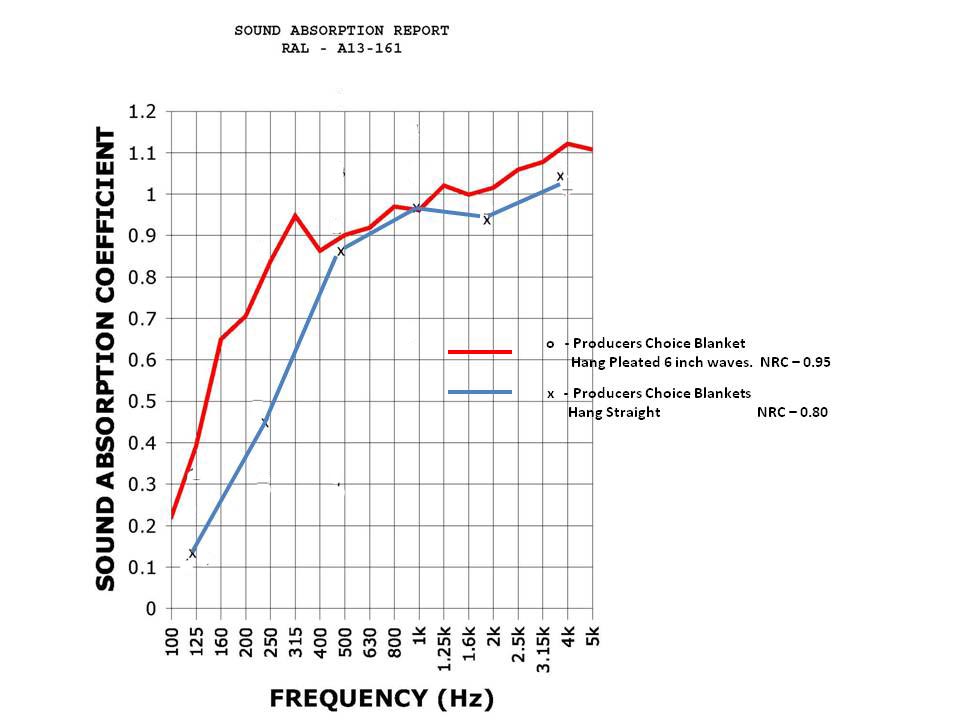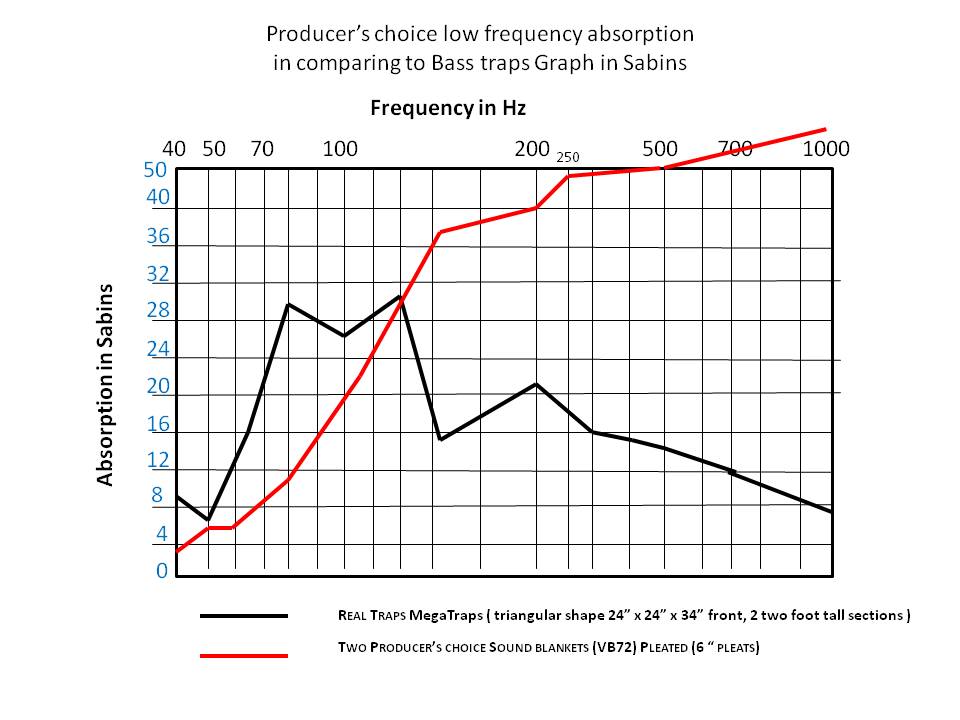Sound blankets are an effective and economical alternative to acoustic foam. In other articles, we discuss the cost efficiency of acoustic sound blankets versus acoustic foam, superior acoustic quality as well as the versatility of applications. This article, however, was triggered by a question of the DVX user forum:
“I haven’t been able to get much feedback on this subject but does anyone have tips or tricks for sound blankets?
Indeed, acoustic blankets might seem like a simple product, and yet if used properly, you can get more for your money than with using acoustic foam. It is also a misconception to think that the blankets are simply a “cheaper” alternative — and if you can afford, you should use acoustic foam instead.
On the contrary, Producer’s Choice Acoustic Blankets have been successfully used by professional film makers with multimillion-dollar budgets such as Century 21 Studios, HBO, and other professional film and music studios worldwide.
So, how do you use acoustic blankets effectively? Here are some tips and tricks to using Producer’s Choice blankets.
USING ACOUSTIC BLANKETS IN A HOME RECORDING STUDIO
This is the first and probably most popular use of the sound blankets. If you are building a home recording studio, there are two things you need to take care of first: make it quiet – Soundproof as much as possible, and make it dead – cut down on reflections, reverberations, and standing waves and so on. You want to do this so the sound does not bounce back from the walls and does not interfere with your recording. This is where the acoustic blankets come in to play.
Tips on Turning an Entire Room into a Studio:
- ORDER MORE ACOUSTIC BLANKETS THAN YOU THINK YOU WILL NEED.
When deciding on the quantity of the blankets – do not try to match blankets to the surface inch by inch. First of all, blankets are not as square and precise cut to size as the foam. The size of the blanket quoted in blanket description is a so called “Cut Size”, after the blanket is bound it takes away and inch or two. When the blankets get fluffed, they get thicker and it also takes away from the size a little. Finally, if you decide to dry clean the blankets or wash them, they can shrink a little more. So effectively, the blanket that is described as 72 x 80 can in fact end up being 70 x76 or so.
- KEEP AWAY FROM THE WALLS
When hanging blankets along the walls, make sure there is an air gap between the wall and the blanket — at least 2 -3 inches. This simple trick increases the sound absorbing efficiency of the blankets by about 40%. For example NRC (noise reduction coefficient) of Producer’s choice blanket positioned 3 inch of the wall is 0.8 (80 % sound absorption) the exact same blanket if applied directly to the wall (laid flat against a hard reflective surface) has NRC of 0.5
- ROUND THE CORNERS.
When you get to the corners, do not try to follow the straight angle of the room – round it up. Let the blanket make a natural rounded curve. This will help greatly on cutting down of long waves and also cut down on standing waves by changing the shape of the room.
- KEEP THE BLANKETS PLEATED
If you hang the blankets in a pleated fashion you add the capacity of the blanket to absorb lower frequency. Allowing for folds in the blanket drastically increases its ability to absorb lower frequencies and adds to the overall NRC values. For example, Producer’s Choice Sound Blankets when tested flat measured at NRC 0.8. If hung in a pleated manner, it measures at NRC 0.95. This increase is contributed mostly by the added lower frequency sound absorption.
- DO NOT FORGET THE CEILING
The ceiling and the floor are two reflective surfaces that often get forgotten when planning for the acoustic room treatment. If you have a thick carpet on the floor that would usually be enough. Ceiling can be covered by a blanket simply by nailing it in right through the blanket. Thin nails with small washer will do just fine. DO NOT use screws! Screws will rip out the inside of the blanket and you will be screwed! Let the blanket sag a little – creating air pockets of a sort.
- COVER THE DOORWAY
You can use wall track mounts to cover the doorway and be able to remove the blankets out of the way.
Turning only a Section of a Room into a Studio
This is something that the acoustic foam cannot do well and the blankets really excel at!
 Use a ceiling track kit and hang the blankets from it. You can draw the blankets to enclose your recording studio when ready to record and pull them away when not in use.
Use a ceiling track kit and hang the blankets from it. You can draw the blankets to enclose your recording studio when ready to record and pull them away when not in use.
By using ceiling tracks you can convert a corner of the room or split the room in half or add an extra coverage to your closet studio. Lots and lots of options!
CORNER BASS TRAPS
Sound absorption blankets can be very effective as corner bass traps. But to effectively absorb low frequencies, the thickness of absorbing material has to be considerably larger than for mid or high range frequencies.
Corners are somewhat of a “hot spot” for lower frequencies, especially in rectangular rooms. The reason is that the sound waves bounce from one corner to the other and at the right wave length they create standing waves on that corner. Place a blanket in that corner with deep pleats. It will change the room geometry from rectangular to odd shaped and will serve as diffuser and absorber at the same time. We did not do any special tests for sound blankets used as a Bass Traps, but from what we have seen so far, Producer’s Choice Sound Blankets can be very effective bass traps when used in the corners folded.
In this graph below we compared low frequency sound absorption of Mega Bass traps from Real Traps.com (http://www.realtraps.com/p_megatraps.htm) with Producers Choice blankets used Pleated. To be fair, due to the nature of the product, the acoustical test method for the Bass Trap is different from acoustical test for sound curtains (G-75 mount), also the depth of absorption material in Mega traps is deeper than in the Producer’s Choice blankets, but as it was shown in previous tests folding acoustic blankets in larger folds dramatically increases the absorption at low frequencies. Therefore if not apple to apples this comparison is an indication of possibility to effectively use Producer’s Choice blankets as corner Bass Traps.
We believe that if the blankets can be folded with at least 12 inch deep pleats they will outperform the Mega bass traps. Further testing is required to have the actual proof.
STAGE SOUND ABSORPTION BLANKETS FOR LIVE BANDS AND “BAR-ROOM MUSICIANS”
Acoustic blankets proved to be very efficient for live bands and performances in a small venue. The blankets are just the right type of gear for musicians that play in different locations every weekend. Some rooms can have extremely back acoustic, yet some venues may not have the room on stage to put tripod stands with premade sound absorbers and Bass Traps.
The tripod stands legs uses a good bit of space. Sound blankets can be suspended in a way without creating a foot print on stage when space is limited.
Musicians told us that when they hung the blankets on the back wall of the stage in a poorly acoustically designed bar room, one that they’ve played multiple times in, it made a major difference in the overall sound quality. In fact, most of the previous issues with “slap back” coming from the back wall were eliminated.


